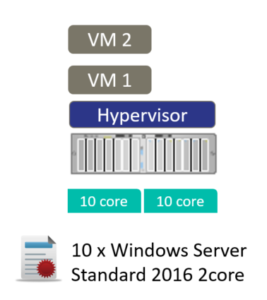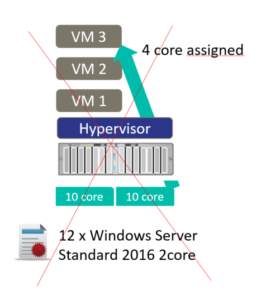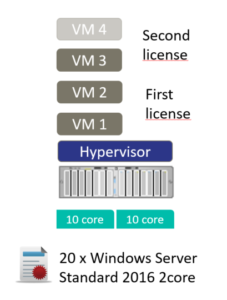
Lately we have received numerous questions regarding the same topic: How to stack Windows Server Licenses correctly within virtual environments; do I only need to license the actual assigned cores when the base license is covered?
To give the answer to this question we first need to explain a bit about Windows Server per core licensing. When a customer wants to install, run and use Windows Server software, such customer must acquire the correct license. Windows Server 2016, both Standard and Datacenter, are licensed in a ‘per core’ model. Customer must license all physical cores in the server with a minimum of 8 cores per physical processor and a minimum of 16 cores per server.
When a customer uses a server with 2 quad core processors (with equals 8 physical cores in that server), customer still needs to obtain a total of 16 core licenses Windows Servers. When a customer uses a server with 2 10-core processors, the amount of core licenses needed is 20 (buy 10 Windows Server 2016 2-core packs).
Virtual installations
When customer has acquired the proper amount of core licenses for Windows Server Standard 2016 and has assigned them to the server, customer has the following rights for installation and usage of Windows Server Standard:
1. 1 physical installation of Windows Server Standard
2. 1 physical installation of Windows Server Standard ánd 2 virtual installations of Windows Server Standard when the physically installed Window Server is solely used for virtualization purposes
3. 2 virtual installations of Windows Server Standard on a non-Windows Server hypervisor, such as standalone Hyper-V or VMware
 Server number three
Server number three
So far so good. There is some confusion about virtual server number 3. We hear a lot that for the virtually installed Windows Server Standard number three customer only needs to acquire the number of core licenses which are assigned to that server (because the base license is already in place). This is not correct.
The correct way
Let’s take a look at what is written in the Microsoft Product Terms (the ‘legal’ document for Microsoft Volume Licensing):
Customer may assign additional Standard edition Licenses to the Licensed Server equal to the number specified in 2 above and use the server software in two additional OSEs on the Licensed Server.
In ‘2’ is written:
The number of Licenses required equals the number of Physical Cores on the Licensed Server, subject to a minimum of 8 Licenses per Physical Processor and a minimum of 16 Licenses per Server.
 In other words, when customer wants to use a third virtually installed Windows Server Standard customer must approach this server as being the first next step and – again – acquire the appropriate amount of core licenses (actual number of cores with minimum of 8 per CPU and 16 per server). When acquired and assigned, customer may use the third, and even the fourth server. All because what we have written down in paragraph 2 ‘Virtual Installations’.
In other words, when customer wants to use a third virtually installed Windows Server Standard customer must approach this server as being the first next step and – again – acquire the appropriate amount of core licenses (actual number of cores with minimum of 8 per CPU and 16 per server). When acquired and assigned, customer may use the third, and even the fourth server. All because what we have written down in paragraph 2 ‘Virtual Installations’.
To remember
Here are some general remarks when using Windows Server software:
1. Please do not forget to acquire the appropriate amount of Windows Server Client Access Licenses (CALs), per device or per user
2. When stacking 7 or more servers, Windows Server Datacenter could be the more cost effective solution due to unlimited virtualization rights
3. When using additional Windows Server Roles, such as Remote Desktop Services (RDS) or Rights Management Services (RMS) customer will need additional RDS and/or RMS CALs
4. Instead of buying additional Windows Server licenses for your next Windows Server virtual installation, you might want to take a look at Azure Virtual Machines as a flexible and possible cheaper alternative
Next step
When this knowledge base article doesn’t help you enough, when you want to know more about Windows Server licensing or simply want a double check on your IT environment, please do contact one of our consultants.
Team Quexcel
The Power of Knowledge
